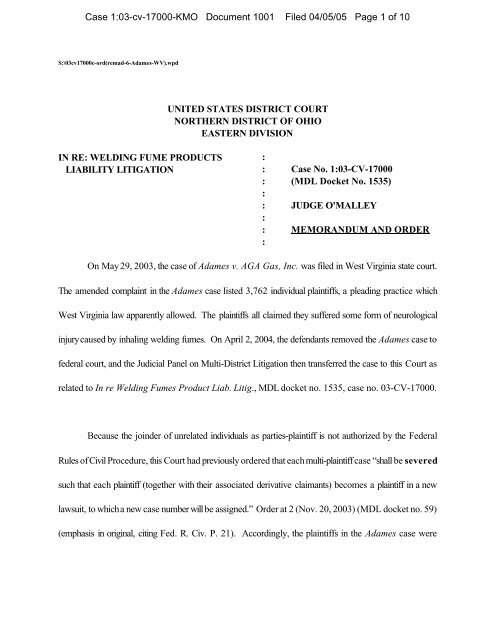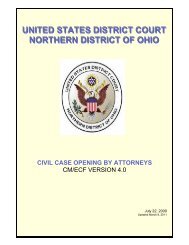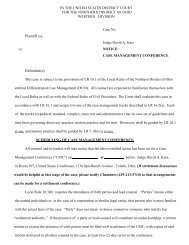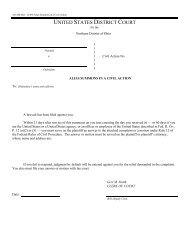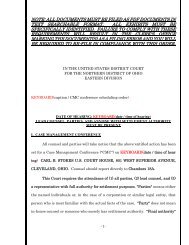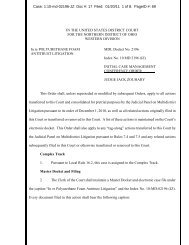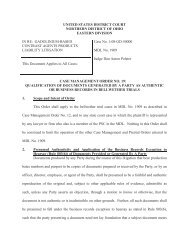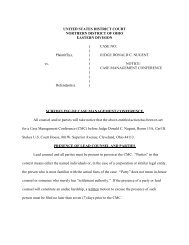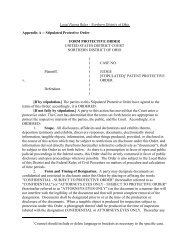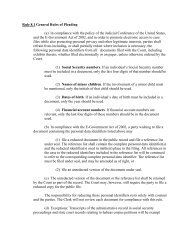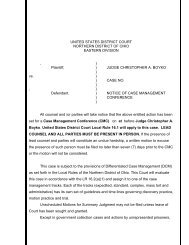1001 - Northern District of Ohio
1001 - Northern District of Ohio
1001 - Northern District of Ohio
Create successful ePaper yourself
Turn your PDF publications into a flip-book with our unique Google optimized e-Paper software.
Case 1:03-cv-17000-KMO Document <strong>1001</strong> Filed 04/05/05 Page 1 <strong>of</strong> 10<br />
S:\03cv17000c-ord(remad-6-Adames-WV).wpd<br />
UNITED STATES DISTRICT COURT<br />
NORTHERN DISTRICT OF OHIO<br />
EASTERN DIVISION<br />
IN RE: WELDING FUME PRODUCTS :<br />
LIABILITY LITIGATION : Case No. 1:03-CV-17000<br />
: (MDL Docket No. 1535)<br />
:<br />
: JUDGE O'MALLEY<br />
:<br />
: MEMORANDUM AND ORDER<br />
:<br />
On May 29, 2003, the case <strong>of</strong> Adames v. AGA Gas, Inc. was filed in West Virginia state court.<br />
The amended complaint in the Adames case listed 3,762 individual plaintiffs, a pleading practice which<br />
West Virginia law apparently allowed. The plaintiffs all claimed they suffered some form <strong>of</strong> neurological<br />
injury caused by inhaling welding fumes. On April 2, 2004, the defendants removed the Adames case to<br />
federal court, and the Judicial Panel on Multi-<strong>District</strong> Litigation then transferred the case to this Court as<br />
related to In re Welding Fumes Product Liab. Litig., MDL docket no. 1535, case no. 03-CV-17000.<br />
Because the joinder <strong>of</strong> unrelated individuals as parties-plaintiff is not authorized by the Federal<br />
Rules <strong>of</strong> Civil Procedure, this Court had previously ordered that each multi-plaintiff case “shall be severed<br />
such that each plaintiff (together with their associated derivative claimants) becomes a plaintiff in a new<br />
lawsuit, to which a new case number will be assigned.” Order at 2 (Nov. 20, 2003) (MDL docket no. 59)<br />
(emphasis in original, citing Fed. R. Civ. P. 21). Accordingly, the plaintiffs in the Adames case were
Case 1:03-cv-17000-KMO Document <strong>1001</strong> Filed 04/05/05 Page 2 <strong>of</strong> 10<br />
severed and assigned their own case numbers. 1<br />
The plaintiffs now move to remand the Adames case and all <strong>of</strong> the constituent severed cases back<br />
to the Marshall County, West Virginia Circuit Court where the case was originally filed (docket no. 676).<br />
For the reasons stated below, this motion is DENIED, without prejudice. 2 Further, the Court ORDERS<br />
the defendants to respond to the Cary Remand Motion (docket no. 647), as explained in Section II.C <strong>of</strong><br />
this Order.<br />
I.<br />
In their removal papers, the defendants asserted that: (1) on March 5, 2004, the defendants learned<br />
that one <strong>of</strong> the plaintiffs named in the Adames complaint, Johnnie Moore, had worked on United States<br />
Navy ships at the Todd Shipyard in Galveston Texas; and (2) the Adames case was, therefore, “removable<br />
pursuant to the Federal Officer Removal Statute, 28 U.S.C. §1442(a)(1), because Mr. Moore’s alleged<br />
exposure to welding fumes . . . would necessarily have involved welding rods designed, manufactured and<br />
packaged pursuant to U.S. government military specifications.” Notice <strong>of</strong> removal at 7. The removing<br />
defendants added that they had two colorable federal defenses that served to fulfill the jurisdictional<br />
requirements: (a) the military contractor defense; and (2) the Defense Production Act.<br />
In their motion to remand, the plaintiffs asserted two arguments: (1) the removal was untimely; and<br />
1<br />
The case numbers assigned to the various Adames plaintiffs range from 04-CV-19197 to 04-<br />
CV-22628, while skipping the range <strong>of</strong> 04-CV-20000 through 04-CV-20999 (which are reserved for<br />
asbestos cases). This represents just over 2,400 plaintiffs; over a thousand <strong>of</strong> the plaintiffs listed in the<br />
original complaint have dismissed their claims.<br />
2<br />
For the meaning <strong>of</strong> the Court’s ruling being “without prejudice,” see section II.B <strong>of</strong> this Order.<br />
2
Case 1:03-cv-17000-KMO Document <strong>1001</strong> Filed 04/05/05 Page 3 <strong>of</strong> 10<br />
(2) neither the military contractor defense nor the Defense Production Act were colorable federal defenses.<br />
After the plaintiffs filed their motion, however, the Court issued a number <strong>of</strong> Orders addressing other<br />
motions to remand; one <strong>of</strong> these Orders concluded that the defendants’ military contractor defense was<br />
colorable, thereby providing a valid basis for federal jurisdiction. See Second Remand Order (docket no.<br />
224) at 13-24. This conclusion applies equally to the Adames remand motion, as the plaintiffs have<br />
recognized. 3 Thus, the plaintiffs now rely only on their argument that the removal was untimely.<br />
Yet another <strong>of</strong> the Court’s earlier Orders, which also addressed other motions to remand,<br />
examined in detail similar timeliness arguments. See First Remand Order (docket no. 101) at 3-8<br />
(discussing, among other things, remand <strong>of</strong> the Ruth case). In the First Remand Order, the defendants<br />
removed the Ruth case from state court well after the 30-day deadline normally imposed by the first<br />
sentence <strong>of</strong> 28 U.S.C. §1446(b). The defendants asserted, however, that this 30-day deadline was<br />
extended by the second sentence <strong>of</strong> §1446(b) – the “other paper” rule – which allows a notice <strong>of</strong> removal<br />
to be filed “within thirty days after receipt by the defendant, through service or otherwise, <strong>of</strong> a copy <strong>of</strong> an<br />
amended pleading, motion, order or other paper from which it may first be ascertained that the case is one<br />
which is or has become removable.” The Court rejected the defendants’ argument, concluding that all <strong>of</strong><br />
the defendants had notice <strong>of</strong> facts revealing the viability <strong>of</strong> removal jurisdiction at least three months before<br />
any defendant actually removed the Ruth case. See First Remand Order at 5-8; see also docket no. 148<br />
at 7 (denying motion to reconsider the First Remand Order). Accordingly, the Court granted the motion<br />
3<br />
In their reply brief, the plaintiffs abandoned their arguments that defendants do not have any<br />
colorable federal defense as to those plaintiffs who worked on United States Navy Ships. With regard to<br />
plaintiffs named in the Adames complaint who did not work on United States Navy Ships, see section II.A<br />
<strong>of</strong> this opinion.<br />
3
Case 1:03-cv-17000-KMO Document <strong>1001</strong> Filed 04/05/05 Page 4 <strong>of</strong> 10<br />
to remand Ruth.<br />
The plaintiffs now ask the Court to apply the same reasoning used in the First Remand Order to<br />
the Adames case. As noted, the Adames case was filed in West Virginia state court on May 29, 2003,<br />
and the defendants removed the case to federal court on April 2, 2004, over 10 months later. The plaintiffs<br />
argue this removal was untimely, and the defendants again seek to rely on the second sentence <strong>of</strong> §1446(b).<br />
Specifically, the defendants argue that: (1) the Adames complaints (both original and first amended) list the<br />
state <strong>of</strong> residency and places <strong>of</strong> employment for none <strong>of</strong> the 3,762 named plaintiffs; (2) the Adames<br />
complaints allege no concrete facts hinting that any one <strong>of</strong> the plaintiffs suffered exposure to welding fumes<br />
while working on a federal enclave or a United States Navy ship; 4 (3) on March 5, 2004, defendants<br />
received the deposition <strong>of</strong> Adames plaintiff Johnnie Moore, who testified he had worked at the Todd<br />
Shipyard in Galveston, Texas; (4) the defendants made inquiries and learned that welders at the Todd<br />
Shipyard do work on United States Navy ships; (5) before that point in time, the defendants had no factual<br />
basis to believe there existed grounds for assertion <strong>of</strong> the military contractor defense; and (6) therefore, the<br />
defendants’ notice <strong>of</strong> removal was filed within 30 days <strong>of</strong> the date <strong>of</strong> receipt <strong>of</strong> a “paper from which it<br />
[could] first be ascertained that the case is one which is or has become removable,” 28 U.S.C. §1446(b).<br />
4<br />
The Adames first amended complaint does include the following “allegation,” which is more in<br />
the nature <strong>of</strong> legal argument: “The federal courts lack subject matter jurisdiction over this action, no federal<br />
question is raised and there is incomplete diversity <strong>of</strong> citizenship. Removal would be improper. Every<br />
claim arising under the Constitution, treaties, or laws <strong>of</strong> the United States is expressly disclaimed (including<br />
any claim arising from an act or omission on a federal enclave or <strong>of</strong> any <strong>of</strong>ficer <strong>of</strong> the U.S. or any agency<br />
or person acting under him occurring under color <strong>of</strong> such <strong>of</strong>fice). No claim <strong>of</strong> admiralty or maritime law<br />
is raised. Plaintiffs sue no foreign state or agency.” Complaint at 57. While an argument could<br />
conceivably be made that this paragraph implies that some <strong>of</strong> the plaintiffs did work on a federal enclave<br />
or a United States Navy ship, the plaintiffs do not actually make this argument, and any such implication<br />
is very weak.<br />
4
Case 1:03-cv-17000-KMO Document <strong>1001</strong> Filed 04/05/05 Page 5 <strong>of</strong> 10<br />
The plaintiffs take issue with the last two points. The plaintiffs argue that, six months before the<br />
defendants received the Moore deposition, the defendants had received another “paper” giving them reason<br />
to know there were grounds to assert the military contractor defense. Specifically, the plaintiffs note that,<br />
on September 9, 2003, the National Electrical Manufacturers Association (“NEMA”) filed an answer in<br />
the Adames case explicitly asserting the government contractor defense. The plaintiffs argue that NEMA’s<br />
service <strong>of</strong> this answer on all <strong>of</strong> the defendants gave them notice that the case was removable pursuant to<br />
§1446(b). The plaintiffs remind the Court that it used essentially this analysis in the First Remand Order.<br />
The Court concludes, however, that there are critical differences between the circumstances<br />
described in the First Remand Order and the circumstances in the Adames case. In the First Remand<br />
Order, the Ruth complaint included explicit allegations that several <strong>of</strong> the Ruth plaintiffs worked at the<br />
Ingalls Shipyard in Pascagoula, Mississippi. The defendants already knew that ships were built at Ingalls<br />
“pursuant to both private and government contracts.” First Remand Order at 5. 5 Thus, it was unsurprising<br />
that, in their answers in Ruth, a dozen or more manufacturing defendants interposed the military contractor<br />
defense, using (for example) the following language:<br />
In the event that any Plaintiff alleges that he was exposed to any <strong>of</strong> Defendant's products,<br />
which were provided pursuant to a contract with the United States Government or<br />
otherwise provided under a contract whereby such products were to meet government or<br />
military specifications then, the use by Plaintiffs <strong>of</strong> Defendant's products, if any, was in<br />
accordance with the requirements <strong>of</strong> the designs, plans, and specifications <strong>of</strong> the United<br />
States Navy or other governmental entities * * * . Defendant specifically pleads the<br />
government contractor defense.<br />
5<br />
Beyond having general knowledge that welders at Ingalls Shipyard frequently worked on Navy<br />
ships, the attorney for one <strong>of</strong> the defendants had previously deposed one <strong>of</strong> the Ruth plaintiffs (Troy Smith)<br />
in another case, at which time Smith had stated he had worked as a welder on “at least 24 U.S. Navy<br />
vessels.” See First Remand Order at 5 n.5.<br />
5
Case 1:03-cv-17000-KMO Document <strong>1001</strong> Filed 04/05/05 Page 6 <strong>of</strong> 10<br />
Lincoln Elec.’s Answer, Thirty-Sixth Defense.<br />
In response to the plaintiffs’ remand motion, the Ruth defendants argued this defense was simply<br />
a “placeholder” mechanism, allowing them to rely upon the defense if and when they discovered facts<br />
supporting it. The Court, however, rejected this “conditional” declaration <strong>of</strong> a defense as merely a<br />
mechanism to avoid the 30-day removal clock: “defendants’ general knowledge <strong>of</strong> the activities at Ingalls<br />
Shipyard and their assertion <strong>of</strong> affirmative defenses apparently borne out <strong>of</strong> that knowledge was sufficient<br />
to trigger their right to remove this action to federal court.” First Remand Order at 5 n.5. Put differently,<br />
“there was enough color to the defendants’ federal affirmative defenses at the time the defendants included<br />
them in their Answers, and enough facts known to the defendants, that removal was required under the<br />
bright-line rule recited in §1446. Reconsideration Order (docket no. 148) at 5-6.<br />
In contrast, in the Adames case, the complaint does not include any allegation even hinting that any<br />
<strong>of</strong> the plaintiffs ever welded on or near a Navy ship, or even in a shipyard, or even in a state where a<br />
shipyard sits. It is probably for this reason that, unlike in the Ruth case, none <strong>of</strong> the manufacturing<br />
defendants asserted the government contractor defense in their answers to the Adames complaint. The<br />
only defendant that asserted the government contractor defense was NEMA; as a trade association,<br />
NEMA is even more distant from the plaintiffs and would have no reason to know where the plaintiffs<br />
worked or what they welded. Thus, NEMA’s choice to assert the defense cannot fairly be characterized<br />
as borne out <strong>of</strong> any knowledge that a given plaintiff welded for the federal government or on government<br />
property. In sum, unlike in Ruth, there was no color to NEMA’s military contractor defense at the time<br />
NEMA included it in its answer.<br />
While the Court remains sure that its jurisdictional rulings in the Ruth case, as set out in the First<br />
6
Case 1:03-cv-17000-KMO Document <strong>1001</strong> Filed 04/05/05 Page 7 <strong>of</strong> 10<br />
Remand Order and the Reconsideration Order, are correct, the defendants did show that the analytical<br />
reed upon which those two Orders rest is slender. See Reconsideration Order at 3-6 (noting that the<br />
defendants’ position had some logic, and that the Sixth Circuit’s view on protective removals is “against<br />
the majority <strong>of</strong> authority”). With their current arguments in the Adames case, the plaintiffs seek too narrow<br />
a reading <strong>of</strong> the defendants’ right to removal under the second sentence <strong>of</strong> §1446(b). The Court concludes<br />
the defendants did timely remove the Adames complaint, given all the circumstances <strong>of</strong> the case at the time<br />
<strong>of</strong> removal.<br />
II.<br />
A. Supplemental Jurisdiction.<br />
As noted, the Adames case was a multi-plaintiff case when originally filed, as well as when<br />
removed; after removal, the Court severed the plaintiffs into over 2,400 separate cases. The defendants<br />
argue that the Court: (1) should exercise supplemental jurisdiction over each one <strong>of</strong> these 2,400-plus cases,<br />
even if the plaintiff in a given case did not weld on a federal enclave or on a United States Navy ship; and<br />
(2) alternatively, if the Court chooses not to exercise supplemental jurisdiction over certain plaintiffs, and<br />
thus chooses to remand their cases, the Court should not allow the remanded plaintiffs to re-join into one<br />
multi-plaintiff case in West Virginia state court.<br />
The Court must reject both suggestions. As the Court has stated previously, it “is generally not<br />
disposed to exercise pendent party jurisdiction, . . . and this inclination only increases when the pendent<br />
party has been severed for improper joinder.” Arredondo Remand Order (docket no. 811) at 3 (citing<br />
7
Case 1:03-cv-17000-KMO Document <strong>1001</strong> Filed 04/05/05 Page 8 <strong>of</strong> 10<br />
28 U.S.C. §1367(c)(3)). 6 Thus, in any individual case where there is no factual basis for the defendants<br />
to assert a colorable federal defense against a specific plaintiff that serves to fulfill the jurisdictional<br />
requirements, the Court does not have and will not exercise jurisdiction. At this juncture, neither the Court<br />
nor the parties knows whether there is such a factual basis in each case. Accordingly, as discussed in<br />
section II.B below, the denial <strong>of</strong> the plaintiffs’ motion to remand in each severed case is without prejudice.<br />
Further, the Court must reject defendants’ suggestion that it enter any subsequent remands “with<br />
the caveat that . . . [the remanded cases] cannot be rejoined in state court.” Brief in opp. at 17. If the<br />
Court concludes it does not have jurisdiction over a given case, then its power over the parties is at an end.<br />
Similarly, this Court has no authority over any other court which does have jurisdiction over the case.<br />
Whether any plaintiffs whom this Court remands to West Virginia state court may later re-join in state court<br />
is a matter for that court, not this one.<br />
B. Without Prejudice.<br />
As a general matter, “a motion to remand may be made at any time before final judgement.”<br />
DaCosta v. Novartis AG, 180 F.Supp.2d 1178, 1183 (D. Or. Aug. 31, 2001); see Duncan v. Stuetzle,<br />
76 F.3d 1480, 1491 (9 th Cir. 1996) (plaintiff’s motion to remand action to state court was timely, even<br />
6<br />
Indeed, the Court’s “inclination” appears to be a requirement in these circumstances. See Ortolf<br />
v. Silver Bar Mines, Inc., 111 F.3d 85, 86-87 (9 th Cir. 1997) (“Supplemental jurisdiction must be<br />
exercised in the same action that furnishes the basis for exercise <strong>of</strong> supplemental jurisdiction. The power<br />
<strong>of</strong> federal courts to exercise supplemental jurisdiction extends to ‘all other claims that are so related to<br />
claims in the action’ when a district court has original jurisdiction ‘in any civil action.’ 28 U.S.C. §1367(a).<br />
The phrases ‘in any civil action’ and ‘in the action’ require that supplemental jurisdiction be exercised in<br />
the same case, not a separate or subsequent case.”) (emphasis added).<br />
8
Case 1:03-cv-17000-KMO Document <strong>1001</strong> Filed 04/05/05 Page 9 <strong>of</strong> 10<br />
though filed one week before trial). This remains true even after an initial motion to remand is denied.<br />
Dacosta, 180 F.Supp.2d at 1183 (denying “without prejudice with leave to renew” a motion to remand<br />
because, although “the current record is insufficient to grant Plaintiffs’ Motion to Remand, Plaintiffs may<br />
renew their challenge to this Court’s jurisdiction in a later motion submitted with proper evidentiary<br />
support”). Given the peculiarities <strong>of</strong> the removal/severance procedure that occurred in the Adames case,<br />
it is virtually certain that a valid basis for federal removal jurisdiction does not exist in some <strong>of</strong> the nowsevered<br />
cases. Only after some discovery has occurred, however, will the parties learn whether there is<br />
a factual, jurisdictional basis for the military contractor defense. Accordingly, the plaintiffs in any <strong>of</strong> these<br />
severed cases may renew their motion for remand, once the jurisdictional facts become clear.<br />
The Court adds, however, that it is hopeful that the parties will file stipulated motions for remand,<br />
in all but the most difficult cases. See Fourth Remand Order (docket no. 810) at 1-2 (noting that the<br />
parties have applied the Court’s prior remand Orders and stipulated to remands in certain cases); id. at<br />
3-9 (giving further guidance on when remand is appropriate by resolving other, disputed cases); Arredondo<br />
Order at 2-3 (giving further guidance). 7<br />
C. Cary Remand Motion<br />
Finally, the Court notes that there remains pending at this time one other motion to remand. See<br />
7<br />
See also Navarro Sav. Ass’n v. Lee, 446 U.S. 458, 464 n.13 (1980) (“Jurisdiction should be<br />
as self-regulated as breathing; . . . litigation over whether the case is in the right court is essentially a waste<br />
<strong>of</strong> time and resources.”) (internal quotation marks omitted)); Hartley v. CSX Transp., Inc., 187 F.3d 422,<br />
425 (4 th Cir. 1999) (“Jurisdictional rules direct judicial traffic. They function to steer litigation to the proper<br />
forum with a minimum <strong>of</strong> preliminary fuss. * * * To permit extensive litigation <strong>of</strong> the merits <strong>of</strong> a case while<br />
determining jurisdiction thwarts the purpose <strong>of</strong> jurisdictional rules.”)<br />
9
Case 1:03-cv-17000-KMO Document <strong>1001</strong> Filed 04/05/05 Page 10 <strong>of</strong> 10<br />
docket no. 647 (moving to remand a number <strong>of</strong> Mississippi cases) (“Cary Remand Motion”). The parties<br />
have informed the Court, however, that they agreed to suspend briefing on this motion because the<br />
resolution <strong>of</strong> the Adames remand motion was likely to be instructive. Accordingly, the Court now<br />
ORDERS the defendants to file a response to the Cary Remand Motion, within 21 days <strong>of</strong> the date <strong>of</strong><br />
this Order, which response will be either: (1) an opposition brief on the merits, incorporating the analysis<br />
set out in this and the Court’s other Orders addressing federal jurisdiction; or (2) a joint stipulated Order<br />
agreeing with the plaintiffs on the extent <strong>of</strong> the Court’s jurisdiction over all <strong>of</strong> the severed cases addressed<br />
in the Cary Remand Motion.<br />
IT IS SO ORDERED.<br />
DATED: April 5, 2005<br />
s/Kathleen M. O’Malley<br />
KATHLEEN McDONALD O’MALLEY<br />
UNITED STATES DISTRICT JUDGE<br />
S:\03cv17000c-ord(remad-6-Adames-WV).wpd<br />
10


